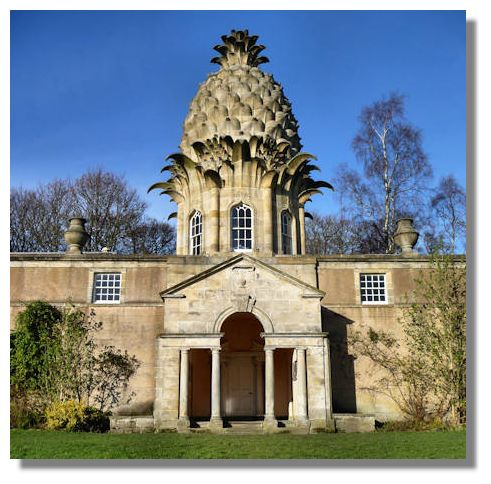The Rampant Scotland Newsletter includes a number of photographs which illustrate the weather and the seasons, plus the flora and fauna of the current week around Scotland. This separate "colour supplement" displays some more pictures, in a larger format. Here is this week's crop of Scottish views!
Described as the "most bizarre building in Scotland" this is a summer house built in 1761 with a first floor of cantilevered masonry in the shape of a realistic, prickly pineapple which is 45 feet high. It was built at a time when pineapples were relatively unknown in Scotland. Four chimneys are disguised as stone vases on top of an adjoining wall, because the summer house was heated by a furnace which circulated hot air through cavities in the wall. There are 16 acres of gardens with an orchard and the property has been restored by the National Trust for Scotland - and can be rented as a holiday home!
Dunmore is just off the A905 road between Falkirk and Stirling and about a mile away, on the same road, is the ancient village of Airth. The present parish church, seen here, dates from the 1820's and has a large graveyard which lies on a slope. Behind the church is the River Forth and beyond that the Ochill Hills, with a light covering of snow. The ruins of a much older church (dating from the 12th century) can be found beside Airth Castle.

The market cross at Airth was erected by a Charles Elphinston in 1697. His initials and coat of arms and those of his mother and father with their arms quartered are on two sides of the cross. Unusually for a market cross, the other two sides of the cross are sun dials and one of them (seen here) has the date 1697. Quite apart from the inaccuracy of sun-dials, you would need very good eyesight to read the numbers at the top of the tall cross from the street below. Charles Elphinston was killed in a duel with a relative, Captain William Bruce of Auchenbowie at Torwood. These days, there is an Elphinstone Inn, adjacent to the market cross.
On the other side of the river Forth from Airth, and slightly further downstream in Fife, is the ancient town of Culross (pronounced "Coo-ross"), an almost perfect example of an ancient Scottish burgh of the 17th and 18th centuries. Many of the houses are of that period and the crows' feet gables, pantile roofs and narrow cobbled streets are typical of that time. A number of the buildings are now owned by the National Trust for Scotland including this fine Town House or "Tolbooth" dating from 1626. It was formerly used as a courthouse and prison.
The "Palace" in Culross (illustrated here) is not associated with royalty but was built for Sir George Bruce, a wealthy merchant and industrialist, in the 17th century. The Palace is particularly attractive both because of the painted wooden ceilings and as the National Trust have filled it with furniture of the 17th and 18th centuries. The building facing the camera was originally an unpretentious late 16th-century dwelling house. George Bruce's initials are carved above one of the windows with the date 1597. A later building, dated 1611 has the initials "SGB" as by that time he was Sir George Bruce! He built the first coal mine in the world to extend under the sea at Culross.
On the outskirts of Culross is an abbey which was founded in 1217 by Malcolm I, Mormaer or Earl of Fife. Culross may have been chosen to establish an abbey because this was reputed to be the birth place of Saint Mungo (also known as Kentigern), the patron saint of Glasgow. It is also possible that the abbey was built over an earlier Pictish church, founded by Saint Serf in the 6th century. In 1633 the east choir of the abbey was taken over for use as a parish church, while the adjoining buildings (seen in the foreground) fell into decay.
This amusing picture of models of a stylised owl and robin was taken in Toward Garden Centre, on the way to Airth and Culross. The expressions on their faces (and that of a fierce-looking blackbird behind) certainly made the customers smile!If you want to look back at earlier editions of this Colour Supplement, there is an Index Page









